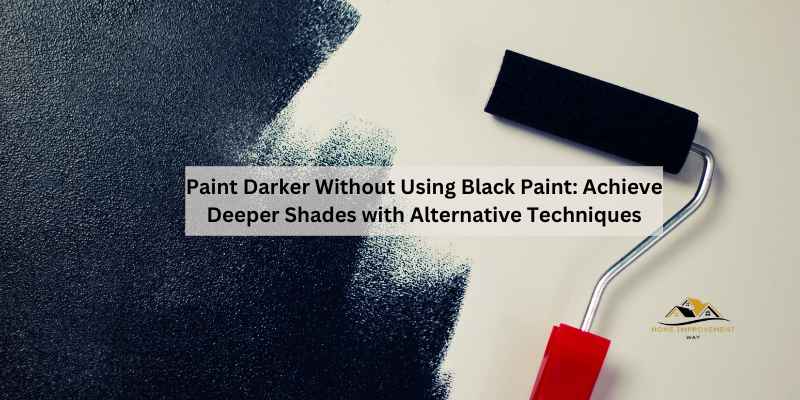To darken paint without using black, mix complementary colors or the darkest hue of the color with its complementary color. This creates a darker shade without adding black paint.
When it comes to painting, achieving the desired darkness without using black paint can be a challenge. Whether you’re looking to intensify a color or avoid a dull appearance, there are various methods to deepen paint tones without resorting to black.
By strategically mixing colors, artists can generate rich, darker hues that maintain vibrancy and depth. This article will explore alternative techniques such as using complementary colors, combining the darkest hues with their complements, and understanding the color wheel to achieve darker shades without incorporating black paint. Additionally, the article will provide insights into the benefits of avoiding black paint and the impact it can have on the overall visual appeal of the artwork.
Mixing Opposite Colors
When it comes to darkening paint without black, mixing opposite colors is a creative alternative. By blending complementary colors strategically, you can achieve deeper tones without relying on black pigment.
Using The Color Wheel
One effective technique for darkening paint is by utilizing the color wheel. Opposite colors on the wheel, also known as complementary colors, can be combined to create darker shades. This method offers a natural and harmonious way to deepen your paint colors.
Creating Black With Complementary Colors
If you want to avoid using black paint, consider mixing complementary colors to achieve a black-like shade. For instance, combining red and green, blue and orange, or yellow and purple can result in a deep, dark color resembling black. Experimenting with these color combinations can lead to unique and rich tones in your artwork.
Utilizing Umber
Utilizing Umber is an effective technique to paint darker without relying on black pigment. Understanding the properties of Umber pigment and its varied hues provides artists with a versatile tool for creating depth and richness in their artwork.
Understanding Umber Pigment
Umber is a natural brown pigment extracted from clay containing iron, manganese, and hydroxides. It offers diverse hues, ranging from yellow-brown to reddish-brown and even green-brown, depending on the proportions of its components. Utilizing umbers can help create a spectrum of dark shades without resorting to black paint, allowing for more nuanced and dynamic color depth in paintings.
Varied Hues Of Umber
There are varied hues of Umber pigment, each with unique properties that lend themselves to different artistic applications. By understanding and leveraging the distinct characteristics of these varied umbers, artists can expand their color palettes and achieve rich, deep tones without the use of black pigment.
Mixing Dark Hues
When it comes to painting, achieving depth and richness in colors is essential. While black paint is commonly used to darken colors, there are alternative methods to create darker hues without the use of black paint. By understanding the concept of complementary colors and knowing how to achieve intensity, you can achieve stunning results in your artwork.
Using Complementary Colors
Complementary colors are pairs of colors that are opposite to each other on the color wheel. When mixed together, they create a neutral gray or brown tone that can be used to darken other colors. For example, to darken an orange tone, you can mix it with a small amount of its complementary color, which is blue. Similarly, if you want to darken a green shade, mix it with a complementary color such as red.
Achieving Intensity
The key to achieving intensity in your colors is to start with the darkest hue of your desired color and then mix it with its complementary color. For example, if you want to darken a purple shade, mix it with a small amount of its complementary color, which is yellow. This combination will create a deep and vibrant shade of purple, without the need for black paint.
By understanding how complementary colors interact with each other, you can create a wide range of dark hues that will add depth and dimension to your artwork. Experiment with different combinations and proportions to achieve the desired darkness and intensity in your colors.
Avoiding Black Paint
When it comes to painting, avoiding the use of black paint can lead to more vibrant and lively results. Many artists seek to paint darker tones without resorting to black, as it can have negative effects on the overall composition and color vibrancy.
Negative Effects Of Using Black
Adding black to achieve darker shades in a painting can often lead to a flat and lifeless appearance. Black pigment tends to overpower other colors, muting their vibrancy and depth. This can result in a dull and monotonous color palette, lacking the dynamic qualities that can be achieved through the use of alternative methods.
Preserving Color Vibrancy
Preserving the vibrancy of colors is crucial for creating captivating artworks. Avoiding black paint allows artists to maintain the depth and richness of their chosen color palette. By utilizing alternative techniques and pigments, such as mixing complementary colors or using dark earth tones like burnt umber, artists can achieve darker shades while preserving the luminosity and complexity of their compositions.
Furthermore, by preserving color vibrancy, artists can create more visually engaging and harmonious artworks that captivate the viewer’s attention and convey a sense of depth and luminosity. This approach to painting darker without black offers a unique opportunity for artists to expand their creative repertoire and explore the diverse range of colors and pigments at their disposal.
Artistic Techniques
Enhancing your paintings by making them darker without using black paint can bring a unique depth to your artwork. By exploring various artistic techniques, you can create rich shadows and tones that add complexity and visual interest to your work.
Creating Depth And Shadows
- Utilize shading techniques to create depth in your paintings.
- Experiment with different levels of contrast to enhance shadows.
- Blend colors strategically to achieve a darker hue while maintaining vibrancy.
Exploring Different Tones
- Mix complementary colors to achieve darker tones without black.
- Consider using earth tones such as umber, which can provide deep, rich color without black pigment.
- Explore color combinations on the opposite ends of the color wheel to achieve darker shades.
Maintaining Color Integrity
Achieve a darker paint color without using black paint by blending complementary colors or mixing the most dark hue of your chosen color with its complementary. This approach allows you to maintain color integrity and experiment with different shades.
Enhancing Richness Without Black
Explore various color combinations to deepen hues without resorting to black paint. Utilize complementary colors to add depth and richness to your palette.
Balancing Darkness And Hue
Find harmony between darkness and color intensity by experimenting with different shades and tones. Avoid the flatness that black can bring and opt for a more vibrant mix of hues.

Frequently Asked Questions
How Do You Darken Paint Without Black?
To darken paint without using black, you can mix equal parts of red, blue, and yellow paint to create a dark shade similar to black. Alternatively, you can mix opposite colors on the color wheel, such as red and green, blue and orange, or yellow and purple.
Another option is to mix blue and brown together. Umber, a brown pigment extracted from clay, can also be used to darken paint.
How Do You Make Black Paint If You Don’t Have Black?
You can make black paint by mixing equal parts of red, blue, and yellow paint. Alternatively, mix opposite colors on the wheel, such as red and green, blue and orange, or yellow and purple. Another way is to mix blue and brown together.
What To Use Instead Of Black In Painting?
To darken paint without black, mix equal parts red, blue, and yellow paint or opposite colors on the wheel like red and green. Blue and brown also create black.
How Do You Darken A Paint Color?
To darken a paint color, mix it with its darkest hue or complementary color for a richer tone.
Conclusion
There are several effective methods for darkening paint without using black. By strategically mixing complementary colors or incorporating dark hues from the same color family, artists can achieve richer and darker tones. Additionally, exploring the use of natural pigments like umber can contribute to creating depth and shadow in artwork.
Embracing these alternative approaches offers a versatile and dynamic palette for artistic expression.


